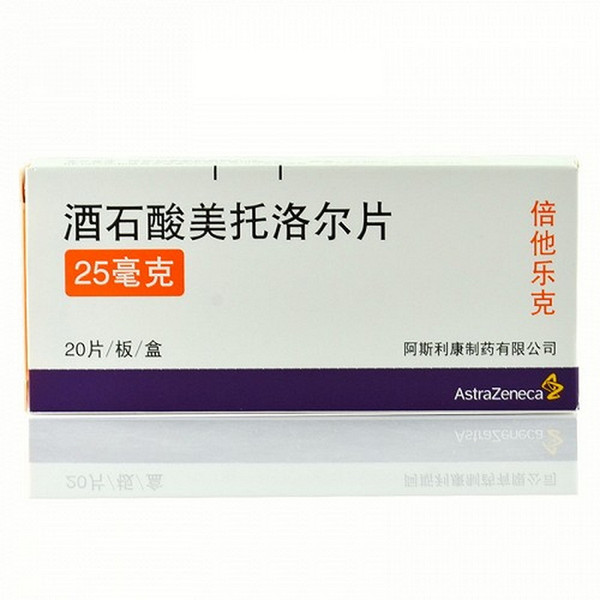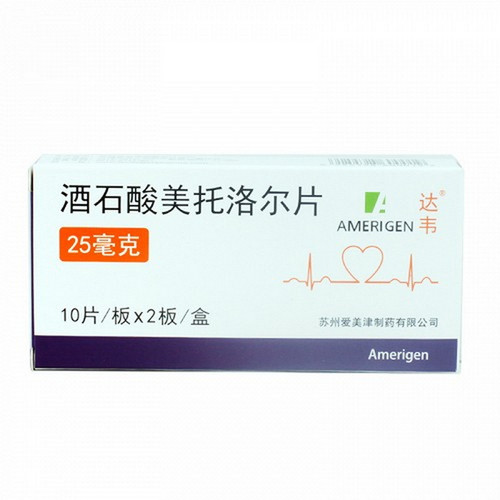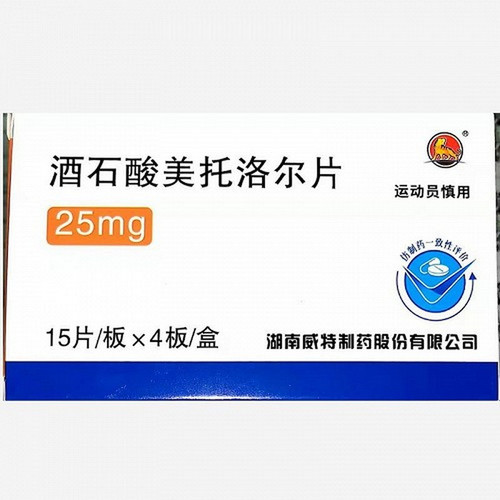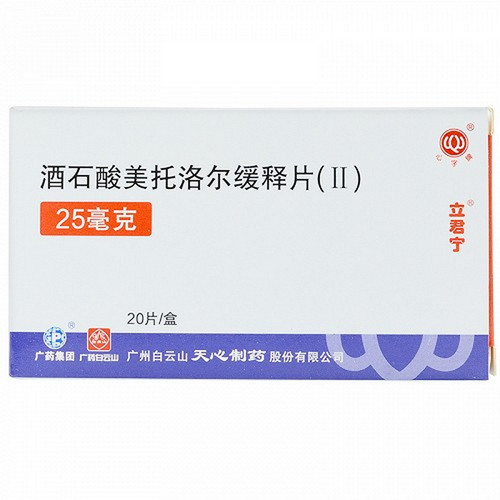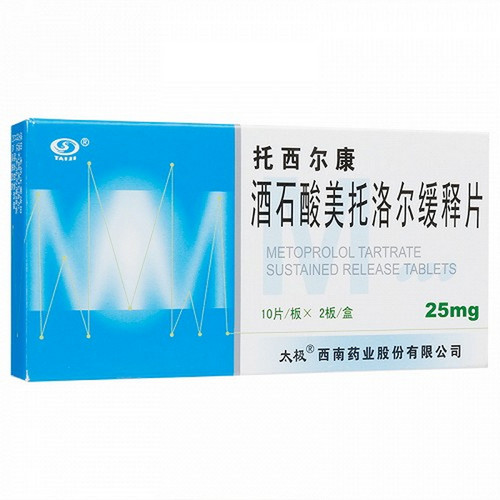Product Overview
[Drug Name]
Generic Name: Metoprolol Tartrate Tablets
Trade Name: Betaloc
English Name: Metoprolol Tartrate Tablets
Chinese Pinyin: Jiushisuan Meituoluo'er Pian
[Ingredients]
The main ingredient of this product is metoprolol tartrate.
[Appearance]
This product is a white tablet.
[Indications]
It is used to treat hypertension, angina pectoris, myocardial infarction, hypertrophic cardiomyopathy, aortic dissection, arrhythmias, hyperthyroidism, and cardiac neurosis. In recent years, it has also been used to treat heart failure; in this case, it should be used under the guidance of an experienced physician.
[Dosage and Administration]
For the treatment of hypertension, 100-200 mg twice daily should be used immediately after hemodynamic stabilization. For acute myocardial infarction, early use, within the first few hours, is recommended because immediate use can reduce infarct size and reduce short-term (15-day) mortality in patients who fail thrombolysis (this effect is apparent within 24 hours of administration). In patients who have already received thrombolysis, it can reduce the rates of reinfarction and reischemia, and if administered within 2 hours, it can also reduce mortality. General Usage: Initially, administer metoprolol intravenously at a dose of 2.5-5 mg/dose (within 2 minutes), every 5 minutes for three doses of 10-15 mg. Then, begin taking 25-50 mg orally 15 minutes later, every 6-12 hours for 24-48 hours, followed by 50-100 mg orally twice daily.
[Adverse Reactions]
1. Cardiovascular System: Decreased heart rate, conduction block, decreased blood pressure, worsening heart failure, peripheral vasospasm leading to cold extremities or palpable pulses, and Raynaud's phenomenon. 2. Due to its lipid solubility and ease of penetration into the central nervous system, this system is prone to more adverse reactions. Fatigue and dizziness occur in 10% of cases, depression in 5%, and other adverse reactions include headaches, dreaminess, and insomnia. Hallucinations may occur occasionally. 3. Digestive System: Nausea, stomachache, constipation (1%), diarrhea (5%), but these are not serious and rarely affect medication use. 4. Other: Dysfunction, joint pain, itching, retroperitoneal fibrosis, deafness, eye pain, etc.
[Contraindications]
II or III degree atrioventricular block, decompensated heart failure (pulmonary edema, hypoperfusion, or hypotension), patients receiving continuous or intermittent inotropic therapy with beta-agonists; clinically significant sinus bradycardia, sick sinus syndrome, cardiogenic shock; poor peripheral perfusion, severe peripheral vascular disease. Metoprolol should not be used in patients with suspected acute myocardial infarction, as manifested by a heart rate of 45 beats/minute, a P-Q interval of 0.24 seconds, or a systolic blood pressure of 100 mmHg. This product is contraindicated in patients with allergies to any of the ingredients.
[Precautions]
1. Propranolol can delay the recovery of blood glucose levels after insulin administration, but this adverse effect is less severe with selective beta-blockers. It is important to note that when diabetic patients taking insulin add beta-blockers, their beta-blocking effects can often mask hypoglycemia symptoms, such as palpitations, thereby delaying timely detection. However, the risk of selective beta-blockers interfering with glucose metabolism or masking hypoglycemia during treatment is lower than with non-selective beta-blockers. 2. If long-term treatment with this drug is interrupted, the dose should be gradually reduced, generally within 7-10 days, with at least three days allowed. In particular, abrupt discontinuation of this drug in patients with coronary artery disease can worsen the condition, leading to angina, myocardial infarction, or ventricular tachycardia. 3. There is no consensus on whether beta-blockers should be discontinued before major surgery.
[Use in Special Populations]
Precautions for use in children: There is limited experience with this drug in children.
Precautions during pregnancy and lactation: Use of beta-blockers during pregnancy can cause various fetal problems, including fetal growth retardation. Beta-blockers can have adverse effects on the fetus and newborn, especially bradycardia, and therefore should not be used during pregnancy or delivery. Elderly Precautions: Pharmacokinetics in the elderly are not significantly altered compared to younger patients, so dosage adjustment is not necessary.
[Drug Interactions]
If patients are concurrently taking sympathetic ganglion blockers, other β-blockers (e.g., current-limiting agents), or monoamine oxidase (MAO) inhibitors, they must be closely monitored. If co-administration with clonidine is planned, be sure to withdraw the β-blocker several days before clonidine withdrawal. Concomitant use of metoprolol with verapamil and dihydropyridine calcium antagonists may increase negative inotropic and chronotropic effects. Verapamil-type calcium antagonists should not be administered intravenously in patients taking β-blockers. β-blockers may increase the negative inotropic and chronotropic effects of antiarrhythmic drugs (quinidine and amiodarone). Inhalation anesthesia may increase the cardiodepressant effect in patients receiving β-blockers. Enzyme-inducing and enzyme-inhibiting substances can affect metoprolol plasma levels. Rifampicin can decrease metoprolol plasma concentrations. Cimetidine, ethanol, hydralazine, and selective serotonin reuptake inhibitors (SSRIs) such as paroxetine, fluoxetine, and sertraline can increase metoprolol plasma concentrations. Pre-existing use of lenalidomide may also increase metoprolol plasma concentrations. Concomitant use of indomethacin or other prostaglandin synthase inhibitors can reduce the antihypertensive effect of beta-blockers. In some cases, patients taking beta-blockers may benefit from the administration of epinephrine. Cardioselective beta-blockers have a much smaller effect on blood pressure control than non-selective beta-blockers. For patients receiving beta-blockers, the dose of their oral hypoglycemic medication must be adjusted.
[Pharmacological Action]
This drug is a Class 2A beta-1 receptor blocker without partial agonist activity (cardioselective beta-blocker). It selectively blocks β1 receptors, lacks PAA (partial agonist activity), and has no membrane-stabilizing effects. Its β1 receptor blocking activity is approximately equivalent to that of propranolol (PP), but its selectivity for β1 receptors is slightly lower than that of atenolol. Metoprolol's cardiac effects, such as slowing heart rate, inhibiting cardiac contractility, reducing automaticity, and delaying atrioventricular conduction time, are similar to those of propranolol and atenolol (AT). Its ability to reduce elevated blood pressure and heart rate during exercise testing is also similar to that of PP and AT. Its contractile effect on vascular and bronchial smooth muscle is weaker than that of PP, resulting in less respiratory effects, but still more potent than that of AT. Metoprolol also reduces plasma renin activity.
[Storage] Protect from light, store in a sealed container.
[Specification] 25mg x 20 tablets
[Packaging] Box
[Expiry Date] 36 months
[Approval Number] National Medicine Standard H32025391
[Manufacturer] Company Name: AstraZeneca Pharmaceuticals Co., Ltd.
